Destiny 2 Review
A sequel that improves on the original in most aspects
I began my review of the original Destiny trying to get a handle on the game. I asked questions about what it was and what it meant, and largely couldn’t come up with an answer. The game felt disjointed, it lacked focus, and struggled to understand what players would like about it - as can often be the case with new blockbuster franchises. But through the DLC and expansions, you could see Bungie starting to understand just what they had in Destiny. Now, three years later, while I don’t know if they have totally figured it out with this sequel, it’s safe to say that this game feels more confident and self-assured than its predecessor.
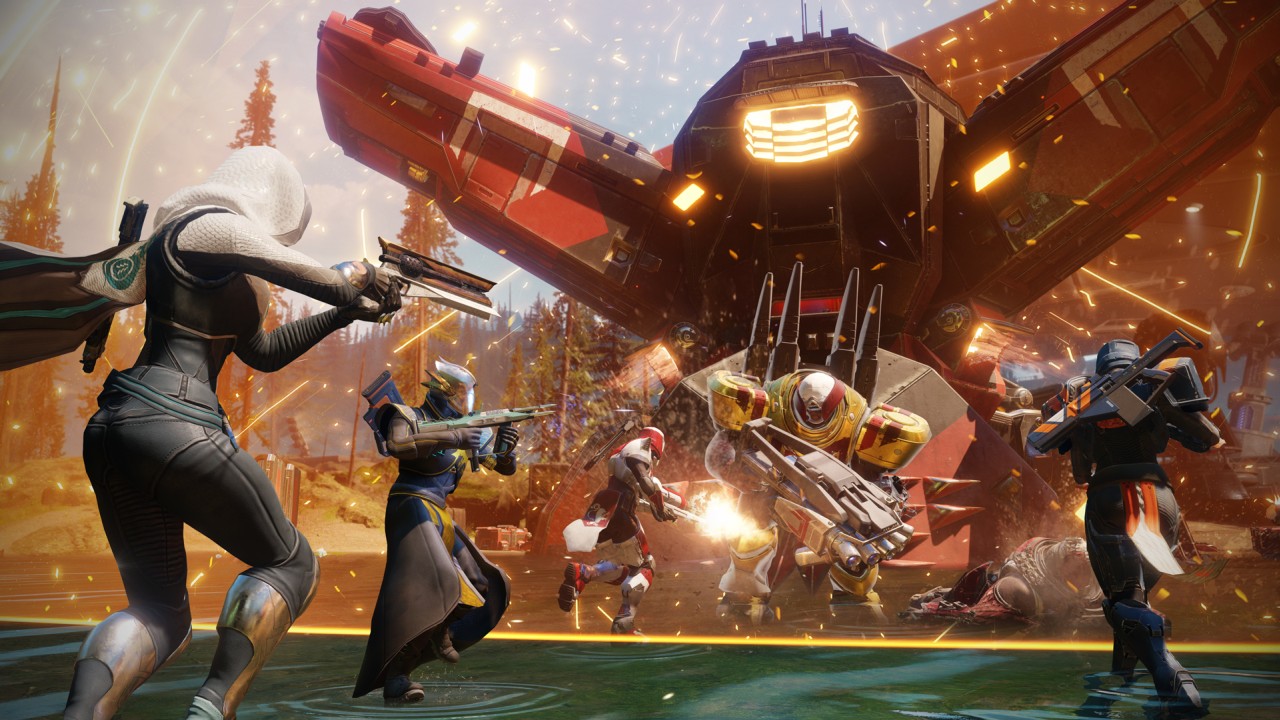
Ostensibly, there’s not much added depth to Destiny 2, and it isn’t a massive departure from the first Destiny. You still build your own character - or import them from the first game – creation options are shockingly the same as in the original. You still spend your time either shooting or holding the action button. You still gather loot to slowly improve your Power level (the new Light level), which continues to climb even after you’ve hit the XP level-cap at 20. The guns are all familiar, ditto for the armor. The physics and the weight of the game is still the same slight departure from Halo. Heck, even the new boss is just a Cabal warlord, an enemy faction from the first game. In many ways, Destiny 2 is just more of the same, but there are differences, starting with the story.
There’s been a big effort to improve the narrative, and the game does a much better job of keeping it’s winding, exhausting lore-monologues to itself this time. The story kicks off during an attack from a Cabal faction called The Red Legion. Led by Dominus Ghaul, the Red Legion break the guardians and take over the last human city on Earth, stealing the Traveler’s Light from you and the rest of the guardians and holding the Traveler and the Speaker hostage. After you have the Light returned to you from a shard of the Traveler, you venture out across the galaxy to find the three members of the scattered elite Vanguard fireteam and retake your home.
Destiny 2 avoids the large exposition dumps of the first game by assuming that most of it isn’t of interest to you. Instead it zeroes in on the Vanguard and exploring them as characters. There isn’t a ton of depth to Commander Zavala, Cayde-6, and Ikora Rey - but it’s more interesting than anything the first game had to offer. It mostly works because Destiny 2 is taking itself less seriously this time; someone apparently tripped off the writers that they can get a lot of mileage out of Nathan Fillion being a goofball, and the likes of whacky characters such as Failsafe add more levity to the proceedings. But overall, Destiny 2 isn’t that interested in telling a compelling story or fleshing out its world, it really just wants you to shoot stuff.
That’s good, because there is a lot of stuff to shoot. It’s hard to disentangle all of Destiny’s different battle arenas as the smaller encounters tend to run together, but Destiny 2 seems to be trying to be a little less linear than the first game. While the game involves more open spaces, I don’t know if Bungie always makes the best use of this design; sometimes it dumps you in a large, beautiful settings but pushes you to hurry through them or overly focus on a boss fight. There’s a mission where you’re trying to find Cayde-6 that features a section filled with the wreckage of an old spaceship, where the Vex and Fallen are shooting it out, but there’s never any time to appreciate the mayhem as the mission pushes you to fight a giant Vex boss.
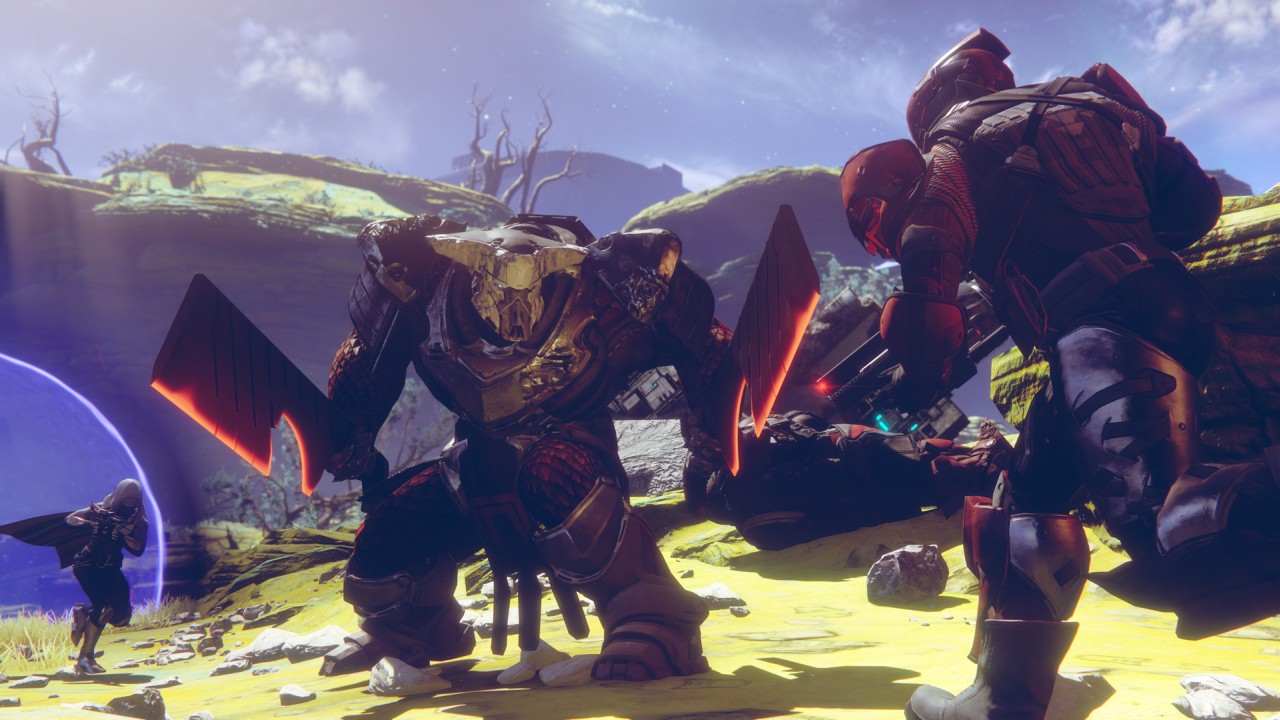
The game still has the same issue where it reuses elements and assets of a single map in multiple different missions. This means you’ll be spending a lot of time revisiting places you’ve already seen. I think there were three or four missions that reused the same open, grassy concourse on Titan, filtering in different enemies depending upon the mission. This might be forgivable when you’re playing single player, as these spaces are usually used differently for each mission, but when you start playing with friends and have to repeat strikes (longer, action-focused missions), story missions, or adventures (brief quests) to help raise their level, it really becomes annoying to retread these maps.
Yet, I have to call out how well Destiny 2 still works in the moment to moment gameplay. The way the shooting and movement handles is excellent. The weight of the weapons makes the shooting feel powerful and the damage feel satisfying. The speed of the action allows you to dodge enemy shots, but also feel in control of the character. The spacial design lets you dodge to and fro on perilous platforms while firing at enemies with little worry you’ll fall off the edge (though I’ve heard disagreement on this point). The hang time of jumps and boosts gives you time to get off impressive headshots. There's even occasional vehicles to drive. Destiny 2 feels great, and at this point, Bungie are such veterans of the shooter genre, it feels like they're showing off.
And it feels even better with a Fireteam. Three is still a weird number to get together and I found it often left one of my friends out, but it’s hard to argue when the design of the game lends itself so well to a threesome. You can do a lot of the adventures and story missions on your own or as a two-person squad, but three people are required for the strikes and it just feels right. Having one person draw fire, while another flanks the enemy, or rushes to revive a fallen comrade is exciting. Having two friends trigger their supercharged abilities while you follow along, picking up the orbs to charge up your own is fun. The game balances itself well with this cooperative multiplayer dynamic.
The team of three is, ideally, supposed to allow for the makeup of a Warlock, a Hunter, and a Titan - the three classes of the game. Each class starts with a sub-class, and two more sub-classes are added as you level up. The sub-classes largely determine the kind of grenades you can throw, what kind of melee attack you have, and your supercharged ability, but they’re not as important as the classes of an MMO for example.
There’s a lot less of the grind from the first game, or at least most of that grind is saved for the late game when you’ve already gotten invested in your character. The added option of fast-traveling without returning to orbit, knocking out missions and seeing the rewards is a lot quicker this time around. The patrol and adventure missions still have a tacked-on feeling and clearly haven’t received the attention to detail as the larger pieces of content. It’s easy to tell those missions are an afterthought because the setpiece moments of Destiny 2 are so impressive, fun and rewarding. You always want to see your loot, get the next gun, and improve your character. With little narrative arc to support the gameplay, it speaks volumes to Destiny 2’s gameplay loop that it’s so compelling.
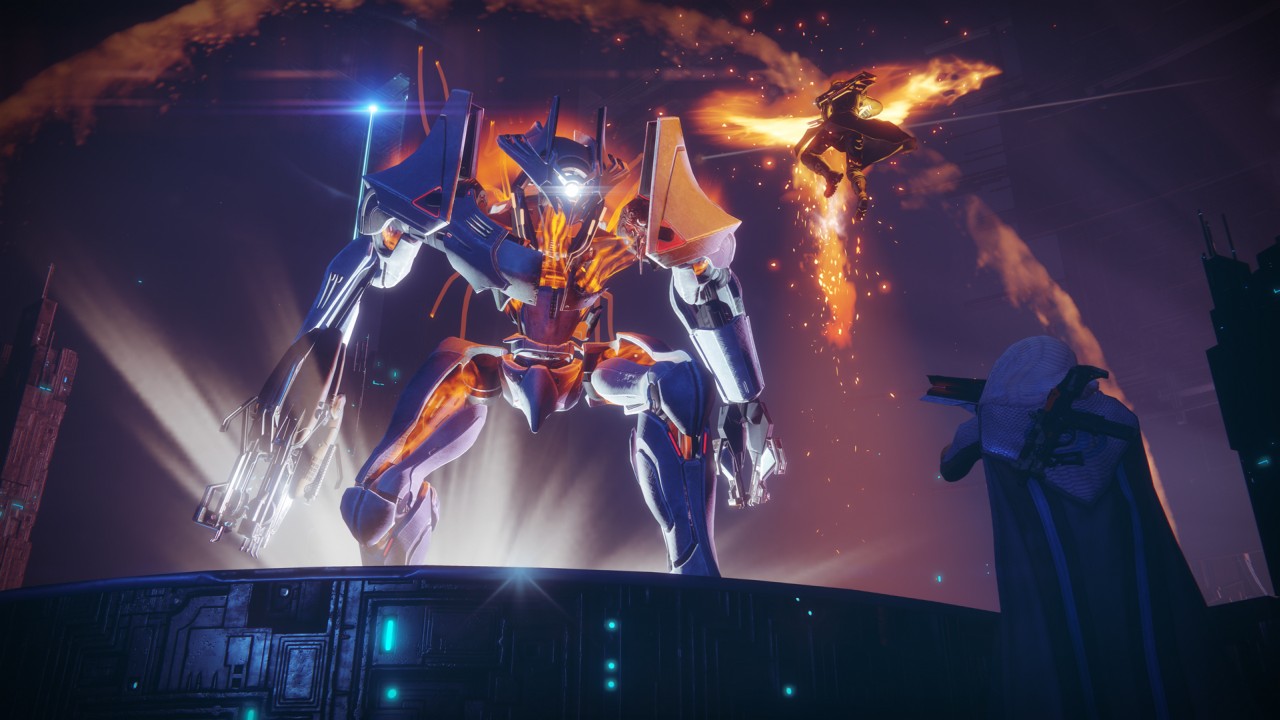
Part of how Destiny 2 encourages this gameplay loop is by walling off content until you’ve hit a certain Power level. Sparrows and strike missions are added in later than in the first game, the real player community space doesn’t open up until you’ve finished the story, and then there’s the endgame content that is taunting you to get good enough to beat it. There’s an encouragement to reach level 230 so you can do the Nightfall Strike, or level 260 so you can access the raid. Then once you have access, the grind is to get good enough that you can beat them on higher difficulty. This leads to you spending an evening in the Crucible, completing the daily objectives on each planet, or completing a milestone so you can get better loot, improve your standing, and attempt to the Nightfall strike or raid again - hopefully better prepared.
Between Power level 200 and 260 is where Destiny 2 really shines. The strikes are still rewarding and after you complete the story, a handful of quests open up that offer high level content for a single player or a Fireteam. Prior to 265, the fastest way to level up is by completing strikes, adventures, replays of story missions, and other content that gives you tokens that can be turned in to quest-givers and Vanguard, who will give you loot. It’s here that you begin min-maxing the reward versus the effort in an attempt to grind out a higher level. For instance, one of the easiest ways to get new weapons is to dismantle guns you don’t need (there’s a lot of them), which earns you tokens with the gunsmith - enough tokens are you’ll get a pretty good reward. It’s after the soft-cap level 265 that things start to really grind and you’ll have to hope for lucky drops or repeating high-level content (Nightfall strikes, raids, and weekly milestones) for marginal stat improvements overtime.
That’s the biggest issue with Destiny 2’s late-game content. It’s where momentum really slows down and becomes less about fun and more about wringing every piece of content for all it’s worth. Eventually the loot all becomes white noise, the strikes become repetitive, and a lot of the content dries up. It’s fun to run the Nightfall strike or raid and see how close you can come to completing it, but that content is tough and requires a group of high-level players. It makes the content hard to enjoy for people who don’t have a Fireteam dedicated to reaching a 280 light level – given that there is no matchmaking.
That’s where guided games comes in. Designed to pair solo players with clans who are a man or two short for Nightfall strikes and raids, this is one of Bungie’s better ideas in Destiny 2. I played a couple of Nightfall strikes this way and it worked pretty well. You have to find people who are wanting to jump on a mic with strangers and it might take a few runs before your teamwork gels, but it seems like a fun way to meet new players and build out a clan with others who are looking to play the endgame content.
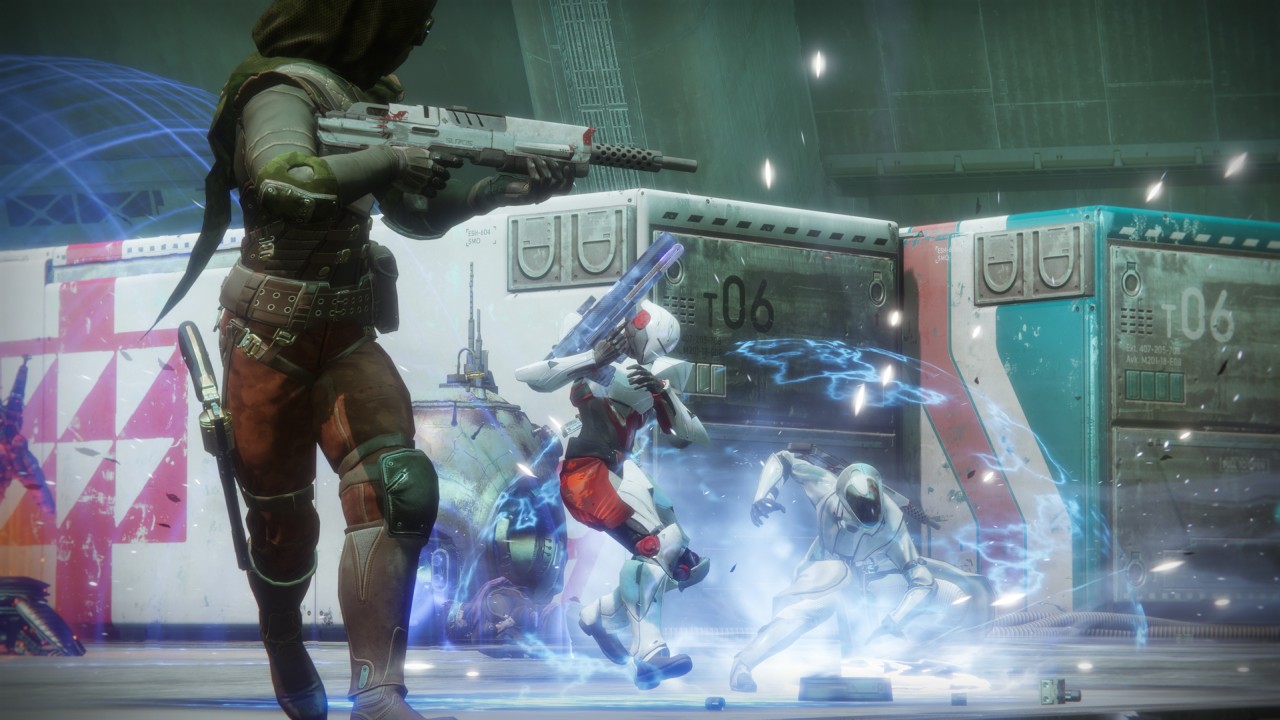
The content and gameplay are really the stars of Destiny 2, which leaves some of the presentation wanting. There are interesting settings and impressive vistas, but the visual and aural design of Destiny 2 didn’t really stand out for me. The reliance on multiplayer is a bit of an issue here. There’s so much going on in Destiny 2, so much communication needed in a Fireteam, so much content packed into locations, that there’s no time to let the game breathe. There’s no atmosphere built in these strange worlds. I don’t remember listening to the waves crash on Titan or the wildlife on Nessus, there’s no time to take in the strange foliage of IO or inspect the crumbing builds in the European Dead Zone.
That being said, the soundtrack is quite good. Headed up by Michael Salvatori (who has collaborated with ex-Bungie composer Martin O’Donnell in the past), the music has a pulsing, electric fury that I liked. Sometimes, Salvatori sounds like he’s recreating tracks from the first game, but this score is edgier than anything Bungie’s done before.
Yet, it seems clear that as Bungie designed the game, the atmosphere they envisioned was one of constant player chatter. It’s another testament to the multiplayer focus that without someone to banter with, Destiny 2 at times sounds empty and hollow, with only the sounds of gunfire to break up the silence. And that’s kind of the point, Destiny 2 doesn’t seem to be seeking immersion, but rather taking pride in being less of an experience and more of a distraction. It seems to not care if you’re going to put a TV show on in the background while you play or chat with friends about your plans for the weekend in between Crucible matches.
The Crucible itself is fun all on its own. The competitive part of Destiny can sometimes get lost with so much emphasis put on the cooperative content, but Destiny 2 has some great maps and game modes to offer. For my money, Supremacy (a mode directly inspired by Call of Duty’s Kill Confirmed mode) is my favorite, as it’s a blast to see people run in to grab the fallen token after a player has been killed, or deny a point the opponent by claiming a fallen comrade’s token. There are two options for Crucible: quick play and competitive. Competitive seems to focus more on the challenges whereas quickplay is a little more casual. There a five different modes and nine different maps so there’s decent variety in what you’ll play. Javelin - 4 was a standout map, as it forced players to use verticality outside the base, while playing to strong team dynamics when indoors - a nice blend. The gameplay of the Crucible encourages teamwork as going alone is a great way to get picked off. The drop from 6v6 player counts in the original to 4v4 in the sequel works well to slow the pace and create more strategic encounters. While it largely works, there were some matchmaking gripes. A few times I found myself on a team of assorted clans while we fought multiple players from a single clan. While other multiplayer games are largely focused on pitting teams against teams and keeping solo-players in their own queue, Destiny 2 struggled with this. It’s also disappointing not to be able to choose playlists of specific modes/maps that interest you.
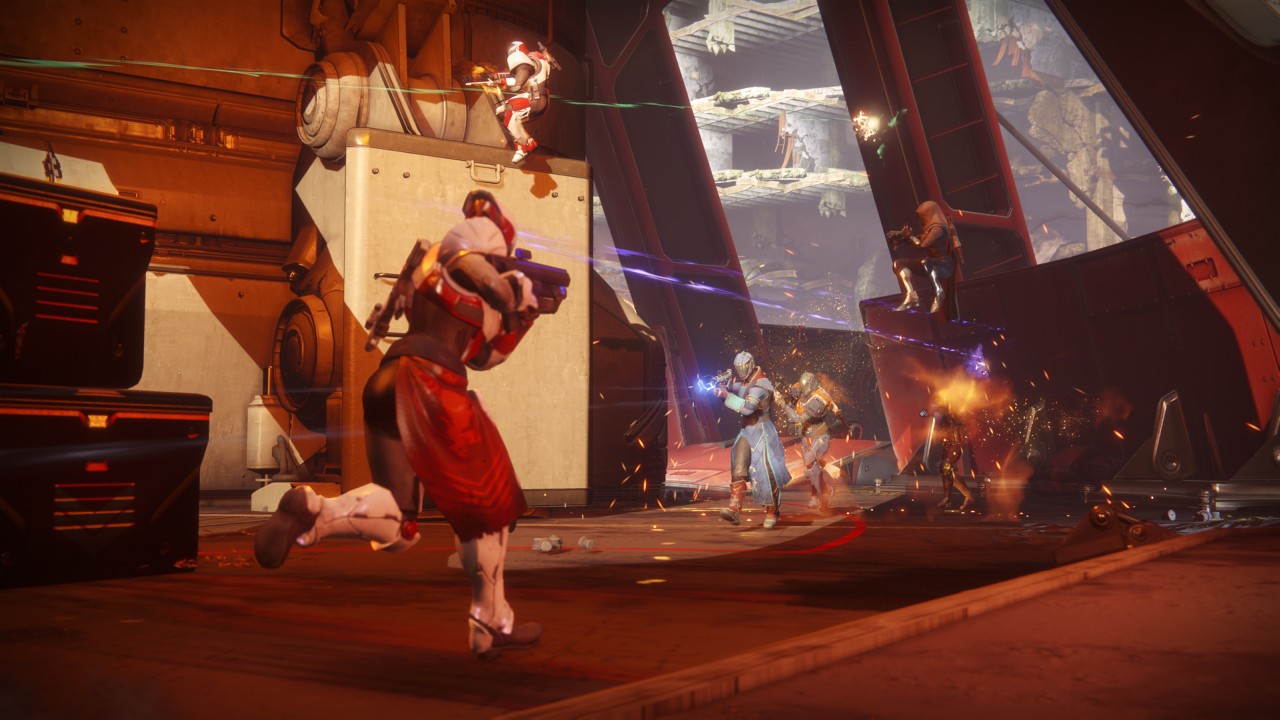
The Crucible also has the longest loading screens of the game, but that’s not to say the overall experience is bad. Getting to and from planets is a much smoother experience than in the first game. There were times voice chat dropped - and I always had to turn down the game volume to hear friends on voice chat. A couple of frame rate drops occurred at checkpoints, but that was it. I can’t recall any time the servers were down or we were booted from a game. For how much of Destiny 2 is running online (that is to say, all of it), it is a solid experience.
A solid experience is what sums up Destiny 2. The game has some nagging design issues, but it also seems to be largely aware of those issues and understands that it’s designed to be a communal space. The game isn’t about story or a constantly living world. It doesn’t try to create an immersive environment or convince you that it offers endless space. Destiny 2 can be a mindless distraction, but that might be reductive considering how much care Bungie seem to have put in here. It isn’t trying to be high art, but rather a social space to share with your friends. It’s something fun to do on a Saturday, a place to chill out after work, and that’s impressive in its own right.
 Comments
Comments



















